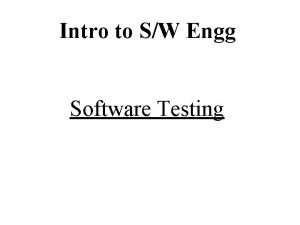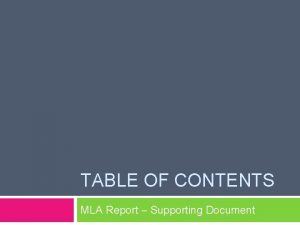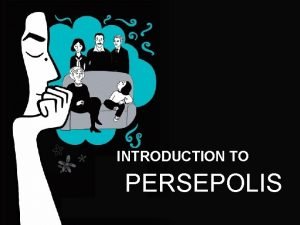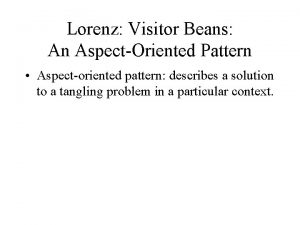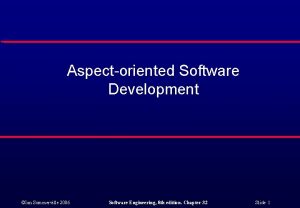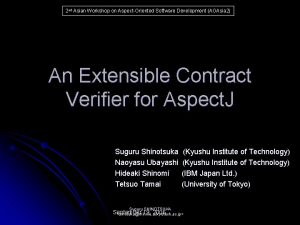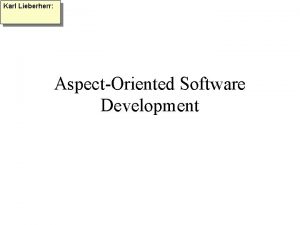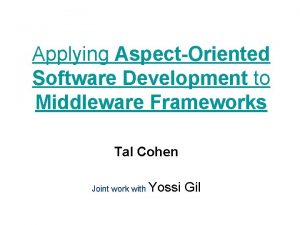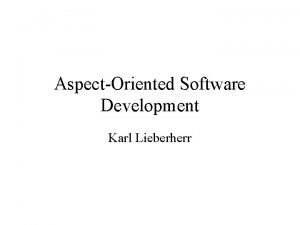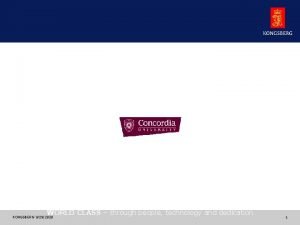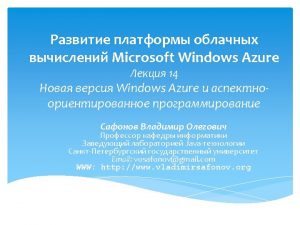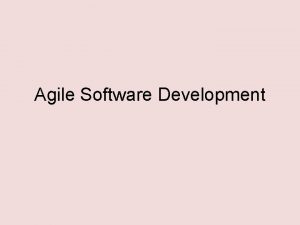AspectOriented Software Development Eric Kenseth Contents History Terminology























![Resources [1] O. Aldawud, T. Elrad, and A. Bader. (2003) UML profile for aspect-oriented Resources [1] O. Aldawud, T. Elrad, and A. Bader. (2003) UML profile for aspect-oriented](https://slidetodoc.com/presentation_image/5ba00cc6320d72e9255fb69f31efeb0d/image-24.jpg)
![Resources (cont. ) [4] James Noble, Arno Schmidmier, David J Pearce, Andrew P Black Resources (cont. ) [4] James Noble, Arno Schmidmier, David J Pearce, Andrew P Black](https://slidetodoc.com/presentation_image/5ba00cc6320d72e9255fb69f31efeb0d/image-25.jpg)

- Slides: 26

Aspect-Oriented Software Development Eric Kenseth

Contents History Terminology Aspect Oriented Programming Analysis Design Patterns Testing Maintenance Conclusion

History Early 90 s, U of Twente, Netherlands Subject-Oriented 1993, IBM Researched similar subjects Feature-Oriented 1997 -2000, Xerox PARC develops Aspect. J True birth of Aspect-Oriented

Terminology Concern Anything any stakeholder wants the system to do. Anything, any stakeholder Cross-cutting Concern Far-reaching concern Applies to many subsections of the system The reason for Aspect Oriented to exist Separation of Concerns Removal of sections in a module that deals with other concerns

Terminology Joinpoint Location where aspects can take over execution Depends on language as to where is supported Method Calls Method Returns Exception Throws Reading/Writing to a field

Terminology • Advice – The code of a cross-cutting concern – Needs to be executed in many places • Pointcut – Points in the program where the advice needs to be executed • Joinpoints • Inter-Type declaration • Declared member of another class in an aspect • Visible only to classed declared to have access

Terminology • Aspect – A class-like structure to encapsulate cross-cut concerns – Can be static or dynamic – Can have fields and methods as members – Can be abstract or not – Can be instantiated – Can have pointcuts, advice, and inter-type declairations – May be ‘privileged’ to access private members of other types

Aspect Oriented Programming Pointcut defines where to execute the Advice may modify program flow Advice may access values in the context of the cut Aspects encapsulate a cross-cut concern Why? Modularization Tangling Scattering How?

Requirements Analysis • What are the concerns? • Which of these are concerns? • Which are cross-cutting concerns? – – – – – Logging Caching Security concerns Error detection Error correction Memory management Real-time issues Synchronization Mutual exclusion Complex rule monitoring

Use Cases Aspect use cases Generalized in situation Detailed in steps Not useful for the client, only the designers Other use cases include the aspect cases a lot

Design Not well supported by UML For now no formally accepted answer Several extensions proposed Some suggest separating base code from aspects in design

Class Diagrams

Sequence Diagrams Very useful when designing with aspects Demonstrates when aspects are invoked Can help spot where pointcuts need to be set

Patterns Spectator Pattern ‘Harmless advice’ Doesn’t modify the other concerns, just watches it Loggers, Tracers, Profilers Regulator Pattern Enforces requirements on the system state May control the flow if errors occur Security Authorization, System Constraints

Patterns Patch Pattern Enhances or Modifies features being Reused Aspects act as methods for a class Add new methods to classes you don’t have access to rewrite Modify methods Allows updating the reused asset without re-modification Must be careful about breaking assertions

Patterns Extension Pattern Making an extendable system is problematic Aspect solution: Create extension points Empty method calls where the system will be extended Extension aspects use these points to add to the system Independent evolution of base code vs. extensions

Implementation concerns Language Specialty language needed. Compiler/Interpreter needs to support aspects Most languages only have minor changes to them

Languages Aspect. J Dozens of other Java-based C/C++/C# based languages Many other languages have Aspect-supporting versions of them Even Cobol

Testing Development aspects can help test and debug base code Logging Tracing Profiling Performance Monitoring These aspects have several advantages Easier to add/remove to the system as aspects

Testing Aspects require different testing means Lack independent identity May be coupled to context New ways for aspects to cause faults Incorrect pointcut patters Incorrect aspect ordering Incorrect context checking in pointcuts Systematic testing means are lacking

Maintenance Add new features without disturbing code. Separation makes modifying cross-cut concerns much easier Untangling makes modifying primary concerns safer Unlikely to break other concerns while modifying. Modifying Joinpoints may be dangerous still.

Reuse Code is modular No tangling with cross-cut concerns in components No scattering of cross-cut concerns in other concerns Many aspects are features useful in almost all systems Logging Tracing Profiling

Conclusion New and emerging Still needs refining in ways Designing Testing Shows promise in certain situations Big, Complex, with multiple user-roles Patching and Extending
![Resources 1 O Aldawud T Elrad and A Bader 2003 UML profile for aspectoriented Resources [1] O. Aldawud, T. Elrad, and A. Bader. (2003) UML profile for aspect-oriented](https://slidetodoc.com/presentation_image/5ba00cc6320d72e9255fb69f31efeb0d/image-24.jpg)
Resources [1] O. Aldawud, T. Elrad, and A. Bader. (2003) UML profile for aspect-oriented software development. In Proceedings of the AOM workshop at AOSD, 2003 [2] Hachani, O. , Bardou, D. (2002) Using Aspect-Oriented Programming for Design Patterns Implementation. In: OOIS 2002 Workshop on Reuse in Object-Oriented Information Systems Design [3] Blair, G. , Blair, L. , Rashid, A. , Moreira, A. , Araujo, J. , Chitchyan, R. (2005). Engineering Aspect-Oriented Systems. In Fillman, Elrad, Clark, Aksit (Eds. ), Aspect. Oriented Software Development (pp. 380 -398). Boston: Addison-Wesley.
![Resources cont 4 James Noble Arno Schmidmier David J Pearce Andrew P Black Resources (cont. ) [4] James Noble, Arno Schmidmier, David J Pearce, Andrew P Black](https://slidetodoc.com/presentation_image/5ba00cc6320d72e9255fb69f31efeb0d/image-25.jpg)
Resources (cont. ) [4] James Noble, Arno Schmidmier, David J Pearce, Andrew P Black (2007) Patterns of Aspect-Oriented Design. In Proceedings of European Conference on Pattern Languages of Programs. Irsee [5] Filman, R. & Friedman, D. (2005). Aspect-Oriented Programming Is Quantification and Obliviousness. In Fillman, Elrad, Clark, Aksit (Eds. ), Aspect-Oriented Software Development (pp. 1 -7). Boston: Addison-Wesley. [6] R. T. Alexander, J. M. Bieman, and A. A. Andrews. (2004) Towards the systematic testing of aspect-oriented programs. Technical Report CS-4 -105, Department of Computer Science, Colorado State University, Fort Collins, Colorado. [7] Aspect. J. (n. d. ). Retrieved October 31, 2009 from Eclipse website, www. eclipse. org/aspect. J

Thank you for your time Questions?
 Lec hardver
Lec hardver What is this?
What is this? Also history physical
Also history physical Introduction for portfolio
Introduction for portfolio Deep perineal pouch contents
Deep perineal pouch contents Trali symptoms
Trali symptoms Ffp clotting factors
Ffp clotting factors Regio thorax
Regio thorax Femoral artery branches
Femoral artery branches Middle mediastinum: contents mnemonic
Middle mediastinum: contents mnemonic The immortal life of henrietta lacks table of contents
The immortal life of henrietta lacks table of contents Contents of internal capsule
Contents of internal capsule Rhomboid major origin and insertion
Rhomboid major origin and insertion Golden lampstand tabernacle
Golden lampstand tabernacle Comic book table of contents
Comic book table of contents Hepatorenal recess
Hepatorenal recess Mla table of contents
Mla table of contents Contents of stylistic lexis
Contents of stylistic lexis School magazine cover page
School magazine cover page Continuous variable example
Continuous variable example Appendix writing
Appendix writing Platelets transfusion indication
Platelets transfusion indication Posterior mediastinum contents
Posterior mediastinum contents Pericardium and mediastinum
Pericardium and mediastinum Contents of an abstract
Contents of an abstract Persepolis table of contents
Persepolis table of contents Persepolis table
Persepolis table

